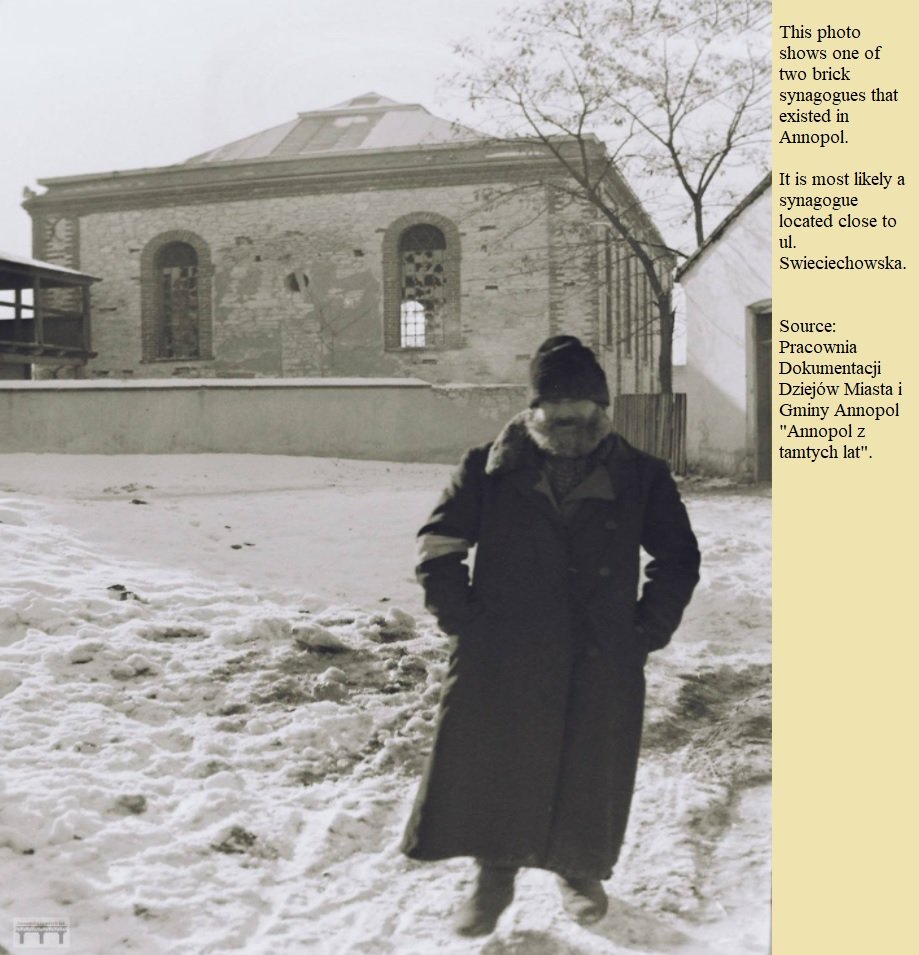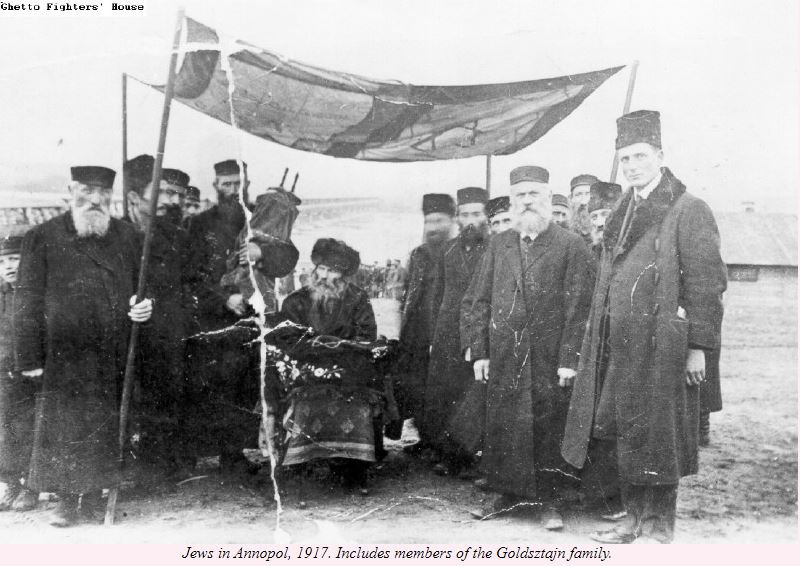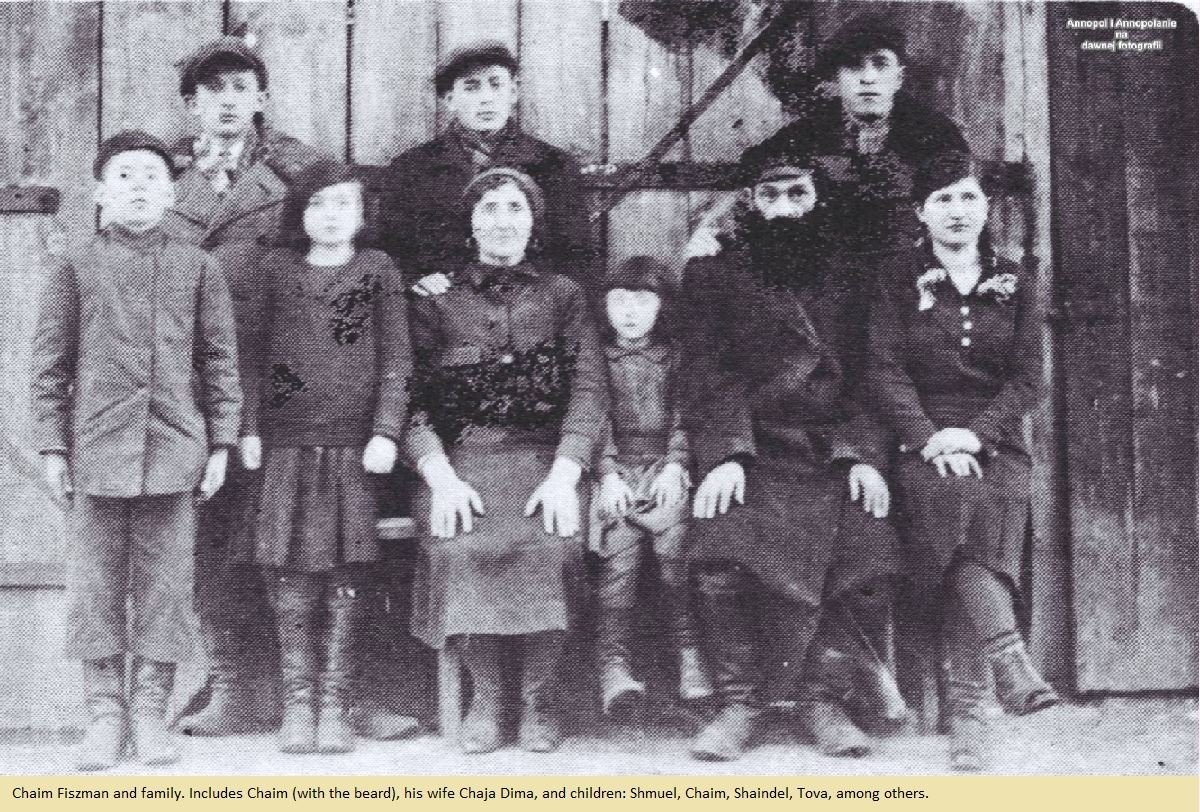Remember Jewish Annopol
According to a 1787 census, Annopol -- called Rachov by the Jews who lived there -- was inhabited by 106 Jews who comprised approximately 44% of the total population of the town. It is unknown when a formal community was established.
There were many Jewish craftsmen, mostly tailors and shoemakers, and Jewish-owned stores and manufacturing/service businesses in the shtetl. There was, in addition, a Jewish hospital funded and financed by the most affluent residents of Annopol. The town became well-known as a center of Torah study.
In the mid-19th century, town authorities issued a decree banning Jews from wearing traditional garments, side locks, and beards. Jewish schools and the Jewish hospital were closed. The situation led to numerous protests by the local Jewish population that sparked anti-Jewish riots. As a result of these events, as well as of the deteriorating economic situation toward the end of the 19th century, Jews began to migrate from Annopol and head for larger cities and locations overseas. Despite this, in 1921 Jews made up 73% of the total population. During the interwar period, 57 Jews worked for Polish farmers as day-laborers. The records additionally mention 50 traders, 94 merchants, 3 cattle traders, 2 horse buyers, and one horse-trader. Most Jews worked in crafts (42%) and trade (37%). The community also included two Jewish cheder teachers, one private tutor, two medical assistants, and two bookkeepers.
In 1931, Annopol was inhabited by 1,388 Jews. A Hebrew school called Tarbut played an important culture-shaping role in the town. Among its students were many members of Zionist youth parties (Hashomer Ha-tzair and Hechaluc Ha-tzair) active in Annopol in the 1930s whose members migrated to Palestine before the outbreak of the war. There was also a small yeshiva which prepared boys ages 14 to 17 to take up studies in the rabbinical school in Lublin (Yeshiva Chachmei in Lublin). The Jewish population in Annopol in August of 1941 numbered 1,814 Jews.
Following the Nazi invasion of Poland in September 1939, Poland found itself under occupation. Shortly after the war had broken out, many Jewish escapees from other towns arrived in Annopol causing an increase in the number of people in the town. In spring 1940, a ghetto in Annopol was created. In May 1942, there were nearly 2,000 people in Annopol, including Jews from nearby villages and smaller localities as well as from Kalisz and Lodz. During the war, the Germans formed a labor camp for Jews in Goscieradow, Lysakow, Janiszow and Rachow. The dissolution of the ghetto began on 15 October 1943.
Jews from the Annopol ghetto were sent to labor camps in Goscieradow (200 total workers at the camp; 100 from Annopol ghetto), Janiszow (900 workers at the camp; 450 from Annopol ghetto), Lysakow (500 workers at the camp; unknown how many from Annopol ghetto), and Rachow (500 total workers at the camp). On October 16, 1942, the Jews of Annopol were forced on foot to walk to Krasnik -- a distance of 30 km. The Jewish men of the town who remained in Annopol, except 100 who were selected for labor, were marched to the town cemetery, and executed.
In November 1943, around 630 Jews were transported to the labor camp in Rachow from Budzyn labor camp, and upon arrival they were shot. These were Jews transported from Austria and Germany.
A group of men who escaped from Annopol before the deportation operation hid in the nearby forests and in early 1943 took part in the liberation of the Jews imprisoned in the Janiszow labor camp.
According to Holocaust survivor Benjamin Orenstein, "Every day, the noose of oppression was tightened; first, the army soldiers desecrated Annopol's synagogue and burned all its sacred books. The next day, they grabbed two notables on the village's bridge and executed them. Their third victim was Jacob Orenstein, cousin of Benjamin; he was killed in front of his two children and his wife while trying to protect her from soldiers’ advances. By 1941, the S.S. had transformed Annopol into an open-air ghetto with a 1 km. perimeter, forbidding the villagers to exit. Orenstein and his three brothers were then deported to neighboring Rachow in October 1942, and later with only one of his brothers to Budzyn. A few months later, that brother was deported back to Rachow where in 1943 he was executed with the rest of the prisoners. Orenstein's remaining brothers were murdered at the Belzec extermination camp.
To the north and west of the marketplace stood a synagogue with a Jewish cemetery nearby. The old Jewish cemetery stopped operation in 1792 and was located on Swieciechowska Street. Currently a health center is at this locale. The new Jewish cemetery in Annopol was established in the 19th century and is situated at Lesna Street. Both cemeteries were destroyed by the Germans during the war.
At the end of the 1820s, the Jewish community in Annopol erected the first synagogue. It was a wooden building, which was located on a synagogue square, northwest of the Annopol market. The second synagogue was made of stone and was located at ul. Swieciechowska. Both synagogues were also destroyed. Today, there is no physical evidence that would indicate a shul stood at either locale.
Please review the site content below. Zachor - We Remember.
------------------------------------------------------------------------
[Annopol Yizkor Book - English] [Annopol Jewish Cemetery]
[Books About Lublin District Jewish Communities]
[Memorial to the Victims of the Janiszow Labor Camp]
[Resources for Finding Your Jewish Family in the Lublin District]
------------------------------------------------------------------------
Annopol LINKS:
Town of Rachov Annopol:
- Article: The Precarious Liberation of the Janiszow Forced Labor Camp
- Book: On the Wings of Faith by Rabbi Eli Fishman
- Remembering the Ludmilowka Pogrom
- Through the Eye of the Needle: Fabric of Survival
Rabbis of Annopol:
- Nachman Rubinsztajn (1828-1878)
- Elimelech Rubinstein (1878-1923)
- Nachman Baruch Rubinstein
- Meir Rosenbaum
- Rafael Leventhal of Czeladz
- Shmarya Finsterbush (Finsterbusz)
Survivors of Annopol:
- Jankiel Bryck
- Rabbi Eli Fishman
- Yumi Goldner
- Falek Krystal
- Josef Krystal
- Benjamin Orenstein
- Jankiel Szyper
- Moshe Szoenbrum
- Sam Wagman
Righteous Gentiles:
- A family in Grabowka hid Chana Szweczkenbaum Schoenbrum.
- A family in Potok sheltered the Grafstein couple.
- Leon Zgardzinski helped the Fiszman family by feeding them.
Remember Your Family:
The DNA Shoah Project: Connecting Descendants
Central Judaica Database - Museum of History of Polish Jews
Grandchildren of Holocaust Survivors on Facebook
Guide to the YIVO Archives
Holocaust News/Events from Generations of the Shoah Int'l
Holocaust Survivors and Victims Database
JewishGen Family Finder
JewishGen Holocaust Database
JRI-Poland: Search for Your Family
Museum of History of Polish Jews Introduction
Yad Vashem: Search for Your Family
Yad Vashem: Submit Names of Your Family Members
Yad Vashem Requests Photos of Shoah Survivors and Families
CONTACTS
U.S.: LublinJewish@gmail.com
Return to Lublin IndexPronunciation: Rachov On-ope-ole










